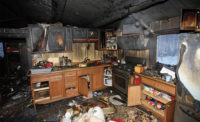The Value of Specialty Restoration to Remove the Unseen Damage After a Fire

Photo credit: venusvi/ iStock / Getty Images Plus via Getty Images
According to the National Fire Protection Association, on average, a fire department responded to a fire somewhere in the U.S. every 23 seconds in 2020. In addition to the obvious structural damage, valuable contents are also at risk of being lost. Some of these items are lost for good, but many can be replaced such as home décor, documents, appliances and textiles.
Once a fire starts, there is a limited amount of time to put out the flames before contents start melting and soot and smoke can begin to permeate objects. Certain types of soot bond can even adhere to the interior of an article requiring complete disassembly of the item to clean and restore the item properly. Did you know, a building can reach over 1,100 degrees Fahrenheit in the first three-and-a-half minutes from the start of a fire?
Luckily, specialty contents restoration companies have the expertise, tools and experience to bring most items back to life. Homeowners and business owners that carry property insurance have access to restoration companies through their insurance carrier. Restoration companies that repair structure and contents work diligently with the policyholder and the adjuster to return the home or business back to its pre-loss condition as soon as possible.
At Prism Specialties, we help the insured and the insurance carrier understand what can and should be restored, and what is best replaced. We consider replacement cost, current value, time to restore and supply chain factors such as, how long it will take to get a new kitchen appliance.
After a specialty restoration company packs out the items that have been deemed restorable, the items are shipped back to the workshop or studio for restoration. Specialized teams of artists, electronic technicians or textile restoration personnel are trained to analyze items based on many types of damage: heat, soot, smoke, humidity, breakage and water.
The most elusive damage is from soot. Often not visible, small particles of soot make it behind artwork glasses, appliance mechanics and electronics boards. Short term, lingering soot in items will cause a smoke smell to persist in the room. Medium to longer term, up to six months or a year, these soot particles can cause corrosion in electronics and the item can stop working. Wipe-downs are rarely enough for items that have soot in interior parts of components. That is why it is important to not just wipe down the outside of items and call them “restored.” Just because it looks fixed doesn’t mean that those bits of soot couldn’t ruin the item down the line.
There is another aspect of fire damage where homes, offices and buildings around the fire may not physically be burned down but are greatly affected by soot and smoke. You typically find these situations where a wildfire starts near a residential or commercial area. According to National Interagency Fire Center (NIFC), the total number of wildfires raging in in the U.S. in August was 91.
People often mistakenly assume that all electronics, appliances, artwork and textiles are unsalvageable. In fact, the opposite is true. Most items can be restored and deodorized through restoration. It is the time and cost of the restoration that most often deems if it should be restored or replaced. What does this mean? If a residential or commercial loss has items in the specialty categories of electronics, appliances, art, collectibles, documents, textiles or anything unique, think about restoration before replacement.
Case Studies
Electronics/Appliances: A fire in a large commercial kitchen attached to a fellowship hall left all kitchen equipment a total loss. Heavy soot affected the audio-visual system, musical instruments, soundboard, speakers and projectors in fellowship hall. A total of 104 items were packed out and 36 items were total losses. The estimated replacement charges for all equipment was $85,000. The restoration cost of restored items was $10,840 for a savings of $74,160.
Textiles: A relatively small fire in a boutique hotel required the hotel to close due to the smoke and soot damage to all the linens. Prism Specialties was on site within hours, packed out 3,500 pounds of linens, cleaned and returned them within 24 hours, and the hotel was back in business.
When choosing a specialty restoration partner, make sure they have the expertise, knowledge and experience to restore the items properly. Another important factor to consider is a warranty or work guarantee, which will provide you and the insured peace of mind on the restored items. Smoke and soot can continue to cause damage even after the fire is put out. Cleaning smoke and soot damage from electronics, art, textiles, and documents require learned skillsets, professional cleaning products and techniques to do the job right. Partnering with the right professional will ensure the items are handled and restored properly, reducing safety risks and potential long-term health risks.
Looking for a reprint of this article?
From high-res PDFs to custom plaques, order your copy today!









